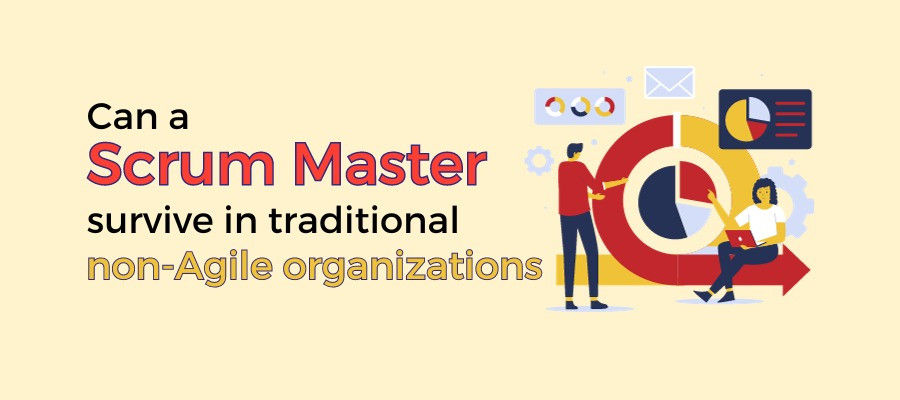Can a Scrum Master Thrive in Traditional Non-Agile Organizations?

Do you work as a Scrum Master? Even when many companies are adapting Agile frameworks like Scrum, many are still far behind the Agile Transformation! In such cases, the role of a Scrum Master becomes crucial! The Scrum Master becomes a true Agile Leader to drive the organization for the successful adoption of Scrum practices. However, the main question is: Can a Scrum Master survive and make a real impact in traditional or non-Agile organizations? Let’s try to find an answer through this article!
Understanding Scrum and The Scrum Master Role:
Let's briefly review the core concepts before delving into the challenges faced by Scrum Masters in non-agile organizations.
Scrum is an Agile framework that emphasizes collaboration among Agile Teams for delivering incremental business value. It consists of roles such as Scrum Master, Product Owner, and Product Developer. Everyone follows the Scrum Principles to achieve the Product Goal while working together within a Scrum Team.
The Scrum Master is not just a project manager; He/She is the Agile Coach of the teams, responsible for performing the following activities:
- Coach and mentor the team members to understand and implement Scrum principles.
- Conduct Scrum Events to ensure effective collaboration between teams.
- Promote self-organization among team members to complete User Stories responsibly.
- Ensure that the team follows Scrum practices
- Facilitate Sprint Retrospectives to help the team reflect on their processes.
- Identify the challenges that can hamper the team’s progress to reach the Product Goal.
So, the Scrum Master ensures that all Agile Teams follow Scrum principles and practices as they deliver Product Increments each sprint.
In traditional organizations with established processes and hierarchies, introducing Agile practices can be challenging. Many of these organizations are rooted in a waterfall or command-and-control approach to project management. They may resist change and be reluctant to embrace Agile methodologies like Scrum. So, where does that leave the Scrum Master?
Challenges Faced By Scrum Masters In Non-Agile Organizations:
Let’s highlight some common challenges the Scrum Master can encounter while handling projects in non-agile organizations:
Lack of Understanding:
In non-Agile organizations, there may be limited awareness of Agile and Scrum. Team members, stakeholders, and management may have little to no experience with these methodologies, which can lead to misconceptions and resistance.
Resistance to Change:
Traditional organizations often resist change, especially if they've been successful with their existing methods. This resistance can manifest as skepticism, reluctance, or even opposition to adopting Scrum practices.
Limited Autonomy:
Scrum Masters thrive in environments that empower them to make decisions and drive improvements. In non-Agile organizations, they may face limitations in their ability to influence change due to rigid hierarchies.
Lack of Agile Mindset:
Agile is not just a set of practices; it's a mindset that values collaboration, adaptability, and customer satisfaction. Instilling this mindset can be challenging in organizations with deeply ingrained traditional values.
Incompatible Processes:
Existing processes and tools may not align with Scrum practices, making it difficult to implement Agile methods effectively.
Strategies Scum Master Can Follow For Survival And Success:
Despite these challenges, Scrum Masters can still make a significant impact in non-agile organizations. Here are some strategies to consider:
Education and Training:
Begin by educating the team and stakeholders about Agile principles and Scrum. Host workshops and training sessions to build awareness and understanding.
Start Small & Align with Leadership:
Introduce Agile practices gradually. Begin with a single team or project and demonstrate the benefits of Scrum through small successes. Gain the support of team members and the trust of business stakeholders by explaining how Agile can lead to improved product quality.
Adapt and Be Patient:
Understand that change takes time. Be adaptable and patient when facing resistance, and focus on continuous improvement.
Measure and Showcase Results:
Use metrics to track progress and showcase the positive impact of Agile practices. Highlight improvements in productivity, product quality, and customer feedback.
Mentorship and Coaching:
Act as an Agile Coach, not just a Scrum Master. You must coach the Scrum Teams, other Scrum Master, Leadership teams, Customers etc.
Advocate for Agile Values:
Promote the Agile mindset within the organization. Emphasize the importance of collaboration, flexibility, and customer-centricity.
Build a Community:
Create a community of Agile practitioners within the organization. Encourage knowledge sharing and peer support.
Key Takeaways For The Scrum Masters:
While the challenges are real, a Scrum Master can indeed survive and thrive in traditional non-Agile organizations. It requires patience and commitment to accept a cultural change. By gradually introducing Agile practices, the Scrum Master can gain the support from leadership and showcase the benefits of Scrum to the team. So, it’s in the hands of the Scrum Master to transform a non-Agile organization into one that embraces Agile principles. In this way, they become not just a Scrum Master but an Agile Leader who drives positive change in non-agile organizations.
Reference:
https://www.scrum.org/resources/blog/how-scrum-masters-can-guide-transition-traditional-approach-scrum



